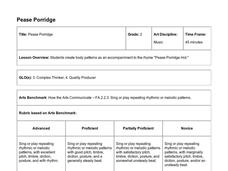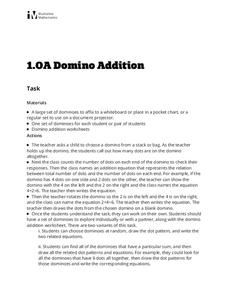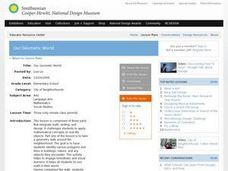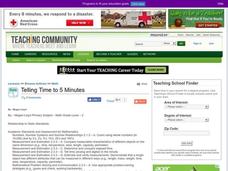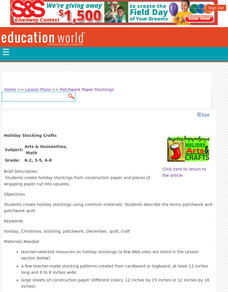Curated OER
Translating Patterns
In this worksheet, students examine picture patterns which have blank boxes beneath each picture. Students translate the pattern by coloring the boxes. Example: rose, rose, bird, rose, rose. (red, red, blue, red, red).
Curated OER
Sequences
In these number sequences worksheets, students complete 19 problems determining the number sequence for each problem. Students improve their number and pattern recognition skills.
Curated OER
Number Cube (Blank)
In this number cube worksheet, learners use the blank number cube pattern for any math purpose. Students write the numbers from 1-6 in the squares, cut out the pattern and paste or tape the cube together.
Curated OER
Number Words
In this number words activity, students draw a line to match the number word in column A to the number that matches in column B. Students complete 10 problems.
Curated OER
Applied Science - Science and Math Post-Lab
Students explore optical illusions. In this Applied Science instructional activity, students view optical illusions and record the data of what they see. Students graph the data that they collect.
Carson-Dellosa Publishing
Boho Birds Bulletin Board
Maybe you're studying the life cycle of a bird, or maybe you're doing an author study in language arts. Whatever the case may be, use a set of bulletin board ideas any time of the year. Tailor the provided ideas to make them your...
Curated OER
Skip Counting to Music
Your youngest mathematicians skip count by 2's, 5's, and 10's as they sing along to a Hap Palmer song that helps them remember the patterns. Students practice in whole group and then individually with the worksheet provided, using the...
Curated OER
Array Bingo
Students recognize patterns in arrays and repeat these patterns back to the teacher. They determine and tell the teacher the total number of squares in the array based on the pattern they recognize.
Hawaiʻi State Department of Education
Pease Porridge
Practice using different ways to express a single pattern. The class uses concrete, pictorial, and numerical modes to represent patterns found in a simple rhyme. They will move their bodies, use body percussion, draw, and use numbers to...
Exploratorium
The Four-Square Quilt
Youngsters recognize that triangles can be combined together to make various shapes. The learning activity provides a series of seven steps that engage children in applying transformations to triangles. Pupils use a quilt template and...
Curated OER
Data Lesson Vital Information
Students prepare and collect data and use excel and create a graph. They collect data about the number of pattern blocks that are put on tables. Students then record that data in Excel.
Curated OER
Counting to 100: Step-by-Step
Introduce your pupils to the hundreds chart! This pair of worksheets is designed to walk them through the patterns they see in the chart as they count by ones and 10s. They fill in missing numbers on a hundreds chart, using guided steps....
Curated OER
A Honey of a Hexagon
Students explore how bees make honey and why the hexagon is the best basic pattern for the honeycomb through the use of a video and hands-on activities with honeycombs and geometric shapes.
Curated OER
Interpreting Data from Birdfeeders
What kinds of birds live in your area? Read a book about birds to your learners and explore their feeding patterns. Charts and graphs are provided in this three page packet, but consider assigning the basic questions if using with young...
Curated OER
Domino Addition
Hands-on learning in math is essential to all learners, especially youngsters. In a math learning activity, young mathematicians use dominoes in order to discover the commutative property of addition. Fact families and doubles facts can...
Curated OER
Our Geometic World
Students walk around the neighborhood and identify various polygons and lines in buildings, nature and other objects. They design a building using various geometric patterns, shapes and lines. Students complete a descriptive writing of...
Curated OER
Understanding 10: Backwards and Forwards
Help your young mathematicians completely master 10 by practicing one-to-one correspondence, number recognition, and recording numbers displayed. They make 10 with groups of two-different colored cubes and color in 10-frames to show how...
Curated OER
Sensational Symmetry
Stdents create symmetrical designs by cutting folded paper in this cross-curricular lesson for the Math and Art classsroom. The lesson is adaptable for any grade or ability level.
Curated OER
Telling Time to 5 Minutes
In this second grade lesson your class will practice telling time. The goal is to tell time to five minutes using an analog clock. Your young students count by 5 minute intervals and discuss elapsed time.
Curated OER
Investigation-Reasoning and Proof
The class explores even and odd numbers.They discuss the results when even numbers are added and when odd numbers are added together. Then work in pairs to find other odd and even pattern examples.
Curated OER
Patchwork Paper Stockings
Youngsters create holiday stockings from construction paper and pieces of wrapping paper cut into squares. It's always nice to have a holiday craft, or two, up your sleeve during December. This craft is easy to implement, and the...
Alabama Learning Exchange
Mix it Up! Exploring the Commutative and Associative Properties of Addition
Examine commutative and associative properties with your class. They'll explore the relationships between addition and subtraction and investigate patterns as they solve addition problems. Links to an assessment and a table game are...
Curated OER
Relate Counting to Addition and Subtraction
Use patterns to practice basic addition; pupils count by two, starting from eight and counting on to 20. They record the five numbers missing from the sequence. Below, the worksheet walks learners through the process...
Curated OER
Decomposing Numbers Step-By-Step
Here are two addition-related exercises. However, bear in mind, the explanations are featured below each of them. Use this as an all-class warm up, revealing the explanations if and when you see fit. First, examine the four sets of...








